Deciding on your first car is always tough. And the arrival of the Datsun redi-GO has only made this decision even tougher. So, to make your life easier, we’ve put the new kid against its European cousin and the country’s long-time bestseller.
Competition breeds excellence. Us critics, we can only make a car look good or bad in your eyes depending on what other options you have. If there were no choices to be made, imagine how boring the process of buying a new car or bike would be – not to mention the fact that we’d be left jobless, too.
Until recently, buying a small entry-level hatchback used to be a no-brainer since there was no real competition to the Alto 800. There’s the Tata Nano and the Hyundai Eon, but the former is perceived as being ‘too cheap’ and the latter a ‘bit pricey’. Things changed drastically, though, with the arrival of the Renault Kwid in 2015. And now the Alto’s stardom has come under serious threat from the Kwid’s close cousin, the Datsun redi-GO. The Renault-Datsun duo has ganged up against the little Suzuki, such that it now finds itself sandwiched between the two – and if you compare them price-to-price and spec-to-spec on an excel sheet, the margin between these three is actually cheese-spread thin.
Looks Matter
Usually, aesthetics don’t matter much when you’ve a budget to stick to. But when the Kwid was unveiled almost a year ago, it proved that a bare-bones entry-level car needn’t be dull. Its pseudo-SUV stance worked very well among consumers – which is small wonder given our nation’s strange affinity towards SUVs, or anything pretending to be one for that matter! Datsun follows the same design philosophy with the redi-GO. Now, the Datsun may be based on the Renault but it’s much more than a mere badge engineering exercise – such as we’ve seen in the past with Renault and Nissan. While these cars share the same basic architecture (CMF-A), both look poles apart from each other. Credit to Datsun here for pulling it off, since, unless you already know, there’s no way you can tell that the redi-GO is a Kwid underneath.
Datsun markets the redi-GO as an urban cross vehicle. In simpler terms, this is a puffed up compact hatchback with a bit of muscle. Dimension wise, it’s shorter than the Kwid but almost as long as the Alto 800. With a ground clearance of 185mm (versus 180mm for the Kwid and 160mm for the Alto), it’s also the most utilitarian of the bunch. The tricky bit here is to choose which one is better looking? And there’s no clear answer to that. I prefer the muscular look of the Kwid, but others may feel as though it’s trying too hard to be a mini-crossover with its squared off wheel arches and black body cladding. The redi-GO, on the other hand, is more modest in its approach. It’s meant to be a modern city runabout, and with its stubby looks it’s sure to do well with consumers of all ages.
Aesthetics is one department where the Alto loses out quite badly in this company. It’s as interesting as a wallflower to look at when parked alongside these two. Maruti may have tried to liven up its style quotient with the most recent update, but it still looks nondescript and dated in front of its rivals.
Inside Job
Even on the inside, the facelifted Alto hardly packs any surprises. It remains functional as ever, and now gets new dual-tone seat fabric and door pads. Most importantly, however, it adds internal adjustment controls for the ORVMs – which both the other cars miss out on. Ergonomically, it scores well with the controls and buttons on the dashboard falling easily to hand, while the steering and pedal position allow for a comfortable seating position. You do, however, sit much lower than in other cars while the cabin overall feels quite cramped and claustrophobic.
If cabin space is one of your top priorities, you should turn your attention towards the redi-GO. Its tall-boy design, coupled with a light grey cabin, give it an airy feel. Getting in and out of the cabin is an easy affair, and the rear bench is spacious. Since you sit upright with a lot of room for your head, the redi-GO comes across as the best car in regards to rear-seat comfort. Other than this, the overall design and layout of the cabin is fresh. But, because it’s short, the driving position is cramped and slightly compromised. While overall quality is markedly better than the Alto, the exposed metal on the door pads and C-pillars are an eyesore and a stark reminder of the obvious cost cutting!
The Kwid’s cabin looks nice, if not a little too dark owing to the excessive use of darker shades. Still, the seats are the most supportive and thanks to it generous footprint it’s quite spacious up front. There are a lot of cubbyholes for your knick-knacks and you’ve got two glove boxes on the dashboard. Rear seat space and comfort will be somewhere between the Alto 800 and the redi-GO. The Renault’s 300 litres of boot capacity is also the highest among the three (redi-GO: 222 litres, and Alto 800: 177 litres).
What attracts you the most about the Kwid’s cabin is its feature list. First and foremost, it gets a touchscreen infotainment system that clubs navigation and Bluetooth telephony controls. That alone is a huge advantage over the regular single-din stereo systems found in the Alto and the redi-GO. The instrument cluster of the Kwid also does away with regular pods and sports a digital display with thick fonts and an informative driver information system that shows instantaneous & average fuel efficiency, distance travelled, distance to empty, and average speed. The redi-GO gets a more traditional speedo, with similar tell-tale systems, although adds a digital tach to its layout. The Alto 800 gets a simple speedometer with digital fuel gauge and trip meters. The Alto and Kwid, however, get the basics right and come with central locking. Even in the top-end variant of the redi-GO, the central locking system is missing.
Frugal, but Whiny
All the contenders lined up in this test are powered by thrummy 800cc three-pot petrol engines. The Renault and the Datsun share their powertrain for obvious reasons, while the Alto uses the F8D 796cc petrol unit from yesteryear, which develops 47bhp and 69Nm. Now, the Suzuki’s motor may be the oldest here, but it leaves the newer motor in the dust in terms of drivability. Response from low revs is the strongest, and the mid-range is decent to amble around in second gear when you’re stuck in moderate traffic. Complementing the sweet motor is the slick-shifting 5-speed manual tranny with short throws and a light clutch. What drivers won’t appreciate here, though, is the whining 3-cylinder motor that can always be heard inside the cabin.
Ideally, the Kwid and the redi-GO’s powertrain – 799cc producing 53bhp and 72Nm – should behave identically on the road. Surprisingly, there’s a discernable difference in the way this motor behaves in the two cars. In the redi-GO, it feels eager at low rpms, which is a boon while trundling in traffic – but there’s this frustrating flat-spot in the mid-range. Start revving it harder, and you’ll soon realise you’re not making any actual progress. But you will have the motor literally shouting its guts out at you. The clutch pedal action is also a notch harder than in the Alto, and the weirdly positioned clutch lever juts out and takes some getting used to.
Surprisingly, the Kwid’s motor is quite well behaved in comparison to the rackety engines of the other two. The NVH levels, for example, are low and the cabin is relatively well insulated in comparison with the other two. Low-end response is comparatively weak though, many-a-time forcing you to shift all the way down to the first gear. The clutch pedal too feels clunky, and you can sense vibrations seeping in through there as well as from the gear lever. Having said that, the Renault’s engine feels the most willing of the three to be revved. Power delivery is linear throughout the mid-range. At higher revs, the engine feels relatively strong – if not a bit coarse. Gearshifts on the Kwid and redi-GO feel more or less the same, with precise but rubbery throws.
The Renault Kwid and the redi-GO also feel lighter on their feet compared to the Alto. This is largely because of the weight difference between these cars – the Alto, at 695kgs, is the heaviest, followed by the Kwid at 635kgs and the red-GO at 625kgs.
Hitting the Road...
Where the Renault truly trumps its rivals is the way it goes down the road. The ride and handling balance is spot-on – the suspension setup is tuned to gobble up bumps and potholes comfortably, without losing much of its dynamic composure in the process. The steering is light for city use and weighs up predictably as the speedo climbs. It’s confident under hard braking. In fact, the Kwid’s road manners definitely feel like something from a segment above.
The Alto’s suspension is also well tuned for our road conditions. It’s slightly on the stiffer side, but doesn’t throw the occupants around as much as you’d expect. Handling is neutral as well, although the steering feels artificial and rigid. Even at low speeds, it required additional effort when negotiating tight turns. However, the Alto’s brakes are progressive – offering the best feel and feedback of the three.
If you spend most of the time stuck in traffic, the redi-GO is the perfect tool for the job. For instance, its tall seating position, accompanied by a large glasshouse, gives you a great all round visibility. Compact dimensions, small turning diameter, and light steering make driving it even easier in traffic. The suspension is tuned for comfort, and it glides over bad patches of tarmac confidently. Carving corners is not its forte, because of its tall-body and puny wheels, but the brakes are adequate – although they do lack any feel, especially during emergency stops.
Kitna Deti Hai?
Fuel economy is unarguably one of the key factors before buying a new car or bike in India. That’s also why you see manufacturers proudly flash the ARAI approved fuel efficiency ratings of their products. And since we’re talking about the entry-level segment, this detail becomes crucial.
As per the ARAI, the Kwid and redi-GO will deliver 25.17km/l while the Alto 800 isn’t not too far off with 24.7km/l. Now, while these numbers look tempting on a glossy sheet of paper, in real world driving conditions they don’t exactly translate that well. Because of the small capacity motors in these cars, even to drive them in the city you really have to wring their tiny engines by the neck. As a result, the fuel economy goes for a toss. Even while driving as sedately as possible, we were only getting around 15-17km/l in these cars.
Final Call
By this time you may have already figured out that this is the Alto 800’s battle to lose. So, has that turned out to be the case then? Well, if you go by sales numbers, the Alto 800 is still the best-selling car in India. There’s no two ways about the fact that it now looks outdated, feels cramped and is not the best-equipped car here. However, the Alto’s reign at the top will continue as long as it’s backed by Maruti Suzuki. Most of the entry-level car buyers come from tier 2 and tier 3 cities where low maintenance costs, reliability and aftersales service trump good looks, better equipment, ride and handling, etc. That being the case, there’s no looking beyond the Alto 800, really.
Now if you’re after a product solely based on its own merits, it should really be between the Renault Kwid and the Datsun redi-GO. The redi-GO looks funky, is more practical, and is a breeze to drive in traffic. On top of that, it’s the most affordable of the three here. The Kwid, however, has pushed the envelope by showing that entry-level cars can be aspirational, too. It feels more mature in the way it drives, it looks striking, and the interior has all the bells and whistles to help it stretch its lead over rivals. Yes, it’s the priciest of the lot. But, the Kwid is worth every extra penny!
- Maruti Suzuki Alto 800
- Datsun Redi-Go
- Renault Kwid
Engine: 796cc / 3-Cylinders / DOHC / 12 Valves
Fuel: Petrol
Transmission: 5-Speed Manual / Front-Wheel Drive
Power: 47bhp @ 6,000rpm
Torque: 69Nm @ 3,500rpm
Price: Rs. 2.49-3.34 lakhs (Ex-showroom, Delhi)
X-Factor: Frugal, functional and cheap to maintain. Driver’s airbag is optional on all variants, and it’s the only one offered with an alternate fuel choice – CNG in this case.
Engine: 799 cc / 3-Cylinders / DOHC/ 12 Valves
Fuel: Petrol
Transmission: 5-Speed Manual / Front-Wheel Drive
Power: 53bhp @ 5,678rpm
Torque: 72Nm @ 4,386rpm
Price: Rs. 2.39-3.34 lakhs (Ex-showroom, Delhi)
X-Factor: Funky styling, spacious interior and comfortable ride make this tall-boy a perfect city runabout. Most affordable 800cc car at the moment.
Engine: 799cc / 3-Cylinders / DOHC / 12 Valves
Fuel: Petrol
Transmission: 5-Speed Manual / Front-Wheel Drive
Power: 53bhp @ 5,678rpm
Torque: 72Nm@ 4,386rpm
Price: Rs. 2.62-3.67 lakhs (Ex-showroom, Delhi)
X-Factor: Mature on-road manners and a peppy engine, clubbed with a feature-rich and practical cabin, mean that the Kwid ticks all the boxes. Nothing else comes close at this price.



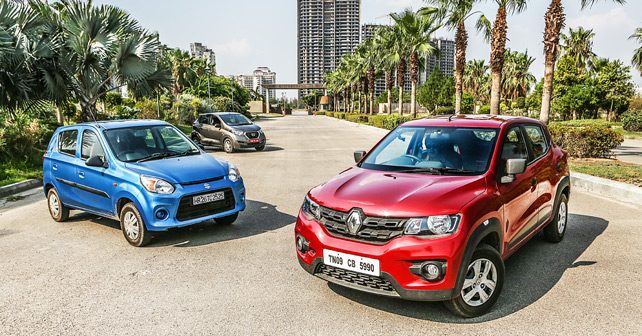
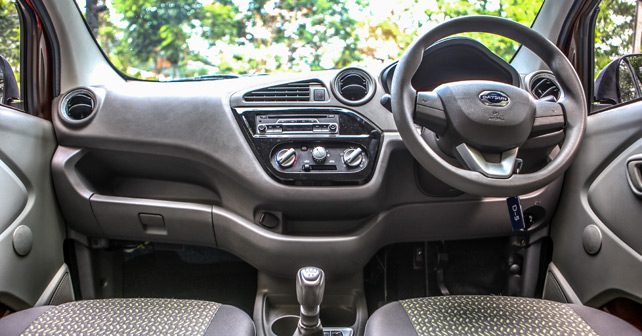

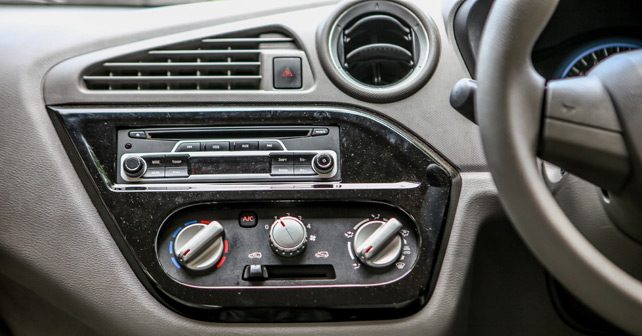

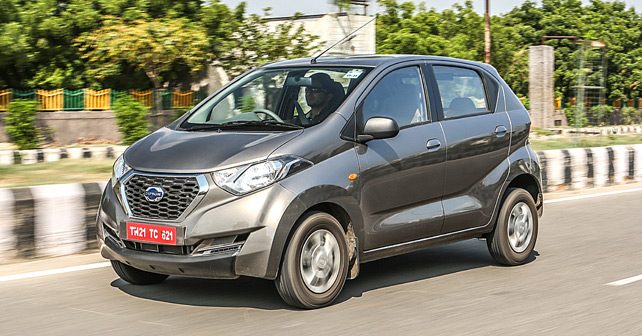







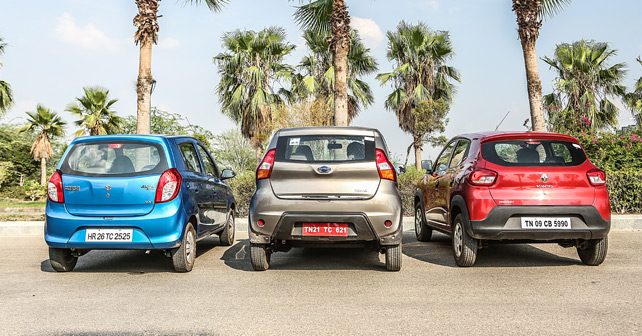



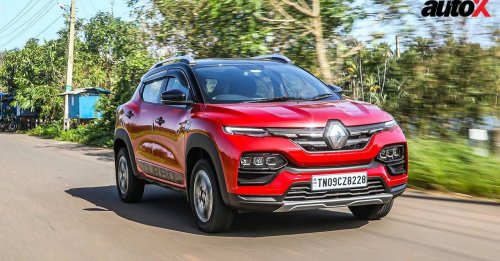
















Write your Comment